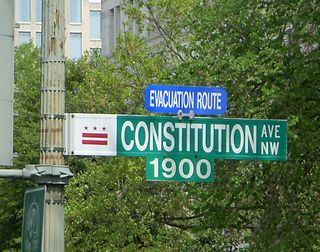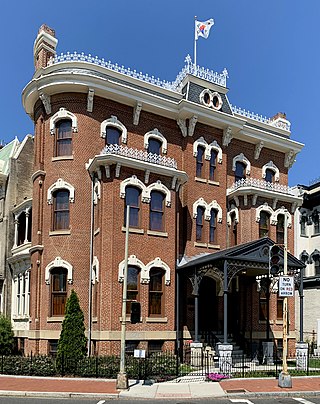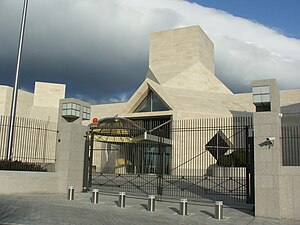
The National Mall is a landscaped park near the downtown area of Washington, D.C., the capital city of the United States. It contains and borders a number of museums of the Smithsonian Institution, art galleries, cultural institutions, and various memorials, sculptures, and statues. It is administered by the National Park Service (NPS) of the United States Department of the Interior as part of the National Mall and Memorial Parks unit of the National Park System. The park receives approximately 24 million visitors each year.

Embassy Row is the informal name for a section of Northwest Washington, D.C., with a high concentration of embassies, diplomatic missions, and diplomatic residences. It spans Massachusetts Avenue N.W. between 18th and 35th street, bounded by Scott Circle to the south and the United States Naval Observatory to the north; the term is often applied to nearby streets and neighborhoods that also host diplomatic buildings, such as Kalorama.

Forest Hills is a residential neighborhood in the northwest quadrant of Washington, D.C., United States, bounded by Connecticut Avenue NW to the west, Rock Creek Park to the east, Chevy Chase to the north, and Tilden Street NW to the south. The neighborhood is frequently referred to as Van Ness because it is served by the Van Ness–UDC station on the Washington Metro's Red Line and is near the Van Ness campus of the University of the District of Columbia (UDC).

The Embassy of Brazil in Washington, D.C. is the diplomatic mission of the Federative Republic of Brazil to the United States of America.

Constitution Avenue is a major east–west street in the northwest and northeast quadrants of the city of Washington, D.C., in the United States. It was originally known as B Street, and its western section was greatly lengthened and widened between 1925 and 1933. It received its current name on February 26, 1931, though it was almost named Jefferson Avenue in honor of Thomas Jefferson.

There are many outdoor sculptures in Washington, D.C. In addition to the capital's most famous monuments and memorials, many figures recognized as national heroes have been posthumously awarded with his or her own statue in a park or public square. Some figures appear on several statues: Abraham Lincoln, for example, has at least three likenesses, including those at the Lincoln Memorial, in Lincoln Park, and the old Superior Court of the District of Columbia. A number of international figures, such as Mohandas Gandhi, have also been immortalized with statues. The Statue of Freedom is a 19½-foot tall allegorical statue that rests atop the United States Capitol dome.

16th Street Northwest, briefly known as the Avenue of the Presidents, is a prominent north-south boulevard in Washington, D.C., located in Northwest D.C. The street was laid out as part of the 1791 L'Enfant Plan, which served as the original blueprint for the city. The street begins just north of the White House, across from Lafayette Square in the President's Park, and continues north along the Washington meridian until Blair Circle.

Old Town Chinatown is the official Chinatown of the northwest section of Portland, Oregon. The Willamette River forms its eastern boundary, separating it from the Lloyd District and the Kerns and Buckman neighborhoods. It includes the Portland Skidmore/Old Town Historic District and the Portland New Chinatown/Japantown Historic District, which are listed on the National Register of Historic Places. It has been referred to as the "skid row" of Portland.
The streets and highways of Washington, D.C., form the core of the surface transportation infrastructure in Washington, D.C., the federal capital of the United States. Given that it is a planned city, the city's streets follow a distinctive layout and addressing scheme. There are 1,500 miles (2,400 km) of public roads in the city, of which 1,392 miles (2,240 km) are owned and maintained by city government.

Sheridan Circle is a traffic circle and park in the Sheridan-Kalorama neighborhood of Washington, D.C. The traffic circle, one of two in the neighborhood, is the intersection of 23rd Street NW, Massachusetts Avenue NW, and R Street NW. The buildings along this stretch of Massachusetts Avenue NW are part of Embassy Row, which runs from Scott Circle to Observatory Circle. Sheridan Circle is a contributing property to the Massachusetts Avenue Historic District and the Sheridan-Kalorama Historic District, both listed on the National Register of Historic Places (NRHP). In addition, the equestrian statue of General Philip Sheridan is 1 of 18 Civil War Monuments in Washington, D.C., that were collectively listed on the NRHP.

The Embassy of the Philippines in Washington, D.C. is the diplomatic mission of the Republic of the Philippines to the United States. It is located at 1600 Massachusetts Avenue, Northwest, Washington, D.C. It predates the independence of the Philippines, and is the oldest Philippine legation overseas, though the distinction of the first Philippine embassy proper overseas, belongs to the Philippine Embassy in Tokyo.

North Cleveland Park is a neighborhood in the Northwest quadrant of Washington, D.C.

Liu Xiaobo was a Chinese literary critic, human rights activist, philosopher and Nobel Peace Prize laureate who called for political reforms and was involved in campaigns to end communist one-party rule in China. He was arrested numerous times, and was described as China's most prominent dissident and the country's most famous political prisoner. On 26 June 2017, he was granted medical parole after being diagnosed with liver cancer; he died a few weeks later on 13 July 2017.

The Sixteenth Street Historic District is a 1.25-mile (2.01 km) linear historic district in Washington, D.C., that includes all structures along 16th Street NW between H Street and Florida Avenue. The district's southern boundary is bordered by Lafayette Square, just north of the White House, and Meridian Hill Park on its northern boundary. It includes an eclectic mix of architectural styles on one of the city's most historic and important numbered streets including single and multi-family residential buildings, embassies, hotels, churches, and office buildings.

The Embassy of Australia in Washington, D.C. is the diplomatic mission of the Commonwealth of Australia to the United States. The chancery is located at 1601 Massachusetts Avenue NW on Scott Circle, at the beginning of Embassy Row. The current ambassador is former Prime Minister Kevin Rudd and the Deputy Head of Mission is Paul Myler. The embassy employs more than 250 people.
Advancing Human Rights (AHR) is an international non-governmental organization that conducts research and advocacy on human rights. AHR's stated objective is to "leverage the tools of democracy to support those fighting for human rights in closed societies." AHR aspires to empower these dissident voices by utilizing crowd sourcing and technology to allow activists around the world to connect to the tools, resources and expertise they need to succeed.

The Embassy of Bangladesh in Washington, D.C. is the diplomatic mission of The People's Republic of Bangladesh to the United States. It is located at 3510 International Drive, Northwest, Washington, D.C., in the Cleveland Park neighborhood. The embassy also operates Consulates-General in New York City, Los Angeles. and Miami.

The Embassy of Pakistan in Washington, D.C. is the diplomatic mission of Islamic Republic of Pakistan to the United States. The embassy also operates Consulates-General in Boston, Chicago, Houston, Los Angeles, and New York City.
Think Tank Row designates the cluster of think tanks that are located on or around Massachusetts Avenue NW in Washington, D.C., between Thomas Circle and Dupont Circle. The expression is a reference to Millionaire Row and Embassy Row, past and present designations for the same area.

The Old Korean Legation Museum is a historic house museum located at 15 Logan Circle NW in the Logan Circle neighborhood of Washington, D.C. Built in 1877 as a residence for military officer and politician Seth Ledyard Phelps, the house served as the legation for the Joseon kingdom followed by the Korean Empire from 1889 to 1905 when Japan took control of Korea's government. The building was sold in 1910 for $10 and later served as a recreation center for African Americans, trade union hall, and private residence.



























